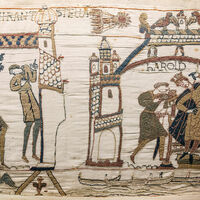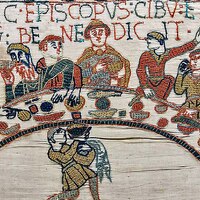Bayeux Embroidery
Type:
Textiles
Date:
ca. 1080
Location or Findspot (Modern-Day Country):
France
Dimensions:
currently 68 m long × 45–53 cm high
Description:
An embroidered textile housed in Bayeux narrates how the Normans—Norsemen who had settled in northern France and become Christians—conquered England in 1066 under their leader, William "the Conqueror." The main action unfolds in the central register, accompanied by short tituli; imagery in the borders often comments on the action satirically or humorously. The embroidery’s commissioner was probably William’s half-brother Odo (ca. 1032–1097), bishop of Bayeux in Normandy and then earl of Kent in southeast England. The textile was most likely made around 1080 at St. Augustine’s Abbey in Canterbury (in Kent), possibly by talented Englishwomen. Abbot Scolland of St. Augustine’s (r. 1072–87), formerly a monk in Normandy, may have helped design it. There are still many unanswered questions about this work, but its usual designation as a tapestry is incorrect; the piece was stitched by hand, not woven on a loom. It is a priceless source for the history, politics, and material culture of its time.
Relevant Textbook Chapter(s):
7
Repository and Online Resources:
• Explore the entire Bayeux Embroidery in high resolution here.
Image Credits:
Digital presentation: City of Bayeux, DRAC Normandie, University of Caen Normandie, CNRS, Ensicaen, Photos: 2017 – La Fabrique de patrimoines en Normandie; Wikimedia Commons
Tags:
Works in textbook,
Christian,
Northern European,
Western European,
Access to the sacred,
Artistic production,
Ideology,
Status and identity,
Animals,
Astronomy and astrology,
Clothing and adornment,
Latin,
Marginalia,
Monasticism,
Relics and reliquaries,
Saints,
Sex and sexuality,
War,
Weapons,
Women





